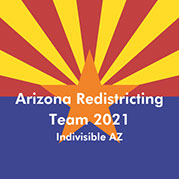Swing Left Maricopa
Creating lasting change. Working for fair districts.
Bias and Noise in Redistricting

A recent article in the New York Times, “Bias Is a Big Problem. But so is “Noise’” describes how some common concepts from statistical data analysis can help us understand some of the difficulties in making decisions. It’s worth thinking about how these concepts might apply to the redistricting process that is going on this year.
In common usage, the word “noise” could refer to the “hiss” that you hear on an old recording, which might come from analog electronics, or from the imperfection of a vinyl record. What you cared about was the music, but you also heard this “extra” sound. But “noise” can mean completely different things than what we can hear; in data analysis, it’s used to describe any part of something that you’re not interested in.
At one point I worked on analyzing electrical signals from the human brain during controlled experiments. For our lab, “noise” was whatever parts of the signal were unrelated to the controlled experimental stimuli we used (for instance, all the parts of the observed brain signals that were not a response to seeing a number on a screen). This noise wasn’t due to any imperfection in the brain, but just came from the many other things that everyone’s brain works on (plus artifacts of the data collection).
In the context of decision making (such as judges determining the sentence for a convicted felon), the Times article explains two concepts: bias, and noise.
Bias is pretty much what you might think, except that it has a more general meaning: it refers to any systematic “error” from the value that you think something should have. So, it doesn’t necessarily refer to prejudice (e.g., racial) per se; for instance, it might be common to think that you are taller than you really are.
But what the article refers to as “noise” is the variation of differing estimates, as opposed to what their average value is. By using the term “noise” for this, the authors are suggesting (quite reasonably) that the variation is undesirable.
How can these ideas be applied to redistricting? On the one hand, we are extremely sensitive to bias. As we have seen so far, the Arizona Independent Redistricting Commission (IRC) has made some critical decisions with a 3 to 2 vote, appearing to lean towards Republicans. This has made the “I” in Independent questionable for some observers (including this one). The suspicion is that there is a proverbial “thumb on the scale”, making it more likely that Republican arguments will be taken more seriously than Democratic ones. This would certainly be a bias. And, charitably speaking, it could be an unconscious one – we all have such biases, based on childhood upbringing and more. But it’s a bias, nonetheless.
But this is pretty commonly discussed, so the contribution of the Times article is to remind us that in addition to any bias in our decisions, there also can be significant variation. This is easiest to see when the outcome can be boiled down to determining a single number, such as a sentence for a particular crime or one’s weight on a scale. But it can also be a major factor in more complex determinations.
This year, new boundaries will be drawn for Congressional and state legislative districts. In Arizona, there are six different criteria for this process, one of which requires strict conformance (compliance with the Constitution and the Voting Rights Act), and five that are criteria that should be met “to the extent practicable.” There are tradeoffs and tensions between these last five criteria. For instance, a focus on “compactness” could diminish “competitiveness.” And some are particularly tricky to define in precise quantitative terms (such as the important notion of respecting “communities of interest.”)
The complexity of this task makes assessment difficult and makes large variation (“noise”) inevitable across proposed district maps. So, when boundaries are drawn here, how can we assess them, knowing that any resulting district map will reflect both the biases of those drawing it, and the inevitable variation of the choices for different maps?
The first thing to check for is bias, since this is more straightforward than handling noise. One might anticipate Republican-leaning groups (including the mapping firm that has been hired) would propose districts that, given past performance, would likely change the partisan representation in their preferred direction. I expect that every progressive group will check for this immediately. And in the unlikely event that Timmons/NDC chose districts that would favor Democrats, there would be a loud shout from Republicans (and a confused response from Democrats).
Beyond that, it will be much more difficult to reduce the “noise” of idiosyncratic choices for map boundaries. It will take a more detailed study of proposed district maps. What is in common between these maps, and what differs? Are the differences essential, or arbitrary? What trade-offs are being made? What implicit assumptions (for instance, about communities of interest) are being made? A map by itself will be impossible to assess without some explanation of the process that went into making it.
The Times article notes that averaging is often used to reduce the effect of noise, a common approach in many endeavors. For instance, in the analysis of brain waves, averaging of experimental trials is often done. It would be far more difficult to “average” maps. That being said, a serious analysis of multiple proposed maps could note what principled assumptions were in common between them and try to find some good middle ground.
For the example of brain waves, we had to reject samples from the average if they appeared to be contaminated by some artifact. Here too, if a map fails the “bias” test, it should simply be rejected. If, for instance, it reduces the current influence of communities of color, it simply must not stand.
For Arizona’s redistricting task, analogies to brain waves or the examples from the Times article are imperfect. But the broad lesson is clear: we must recognize the effects of both bias and “noise”, even when the latter is extremely hard to quantify. But it is critical that the public embrace its crucial role in monitoring and reacting to the Commission’s handling of these factors. We must encourage the Commissioners’ “better angels” to choose fair boundaries for districts in the next decade, which will have enormous effects on our communities’ health and welfare. And the heaviest burden for this will weigh on the IRC Chair.
Nelson Morgan
OUR MISSION
Swing Left Maricopa connects activists to the most impactful actions in support of Democratic candidates in the most flippable districts and offices throughout Maricopa County and at every level of government.
In 2021, we will also focus on providing information about the work and process of the Arizona Independent Redistricting Commission and helping the public provide meaningful and timely input into the process.
STAY INFORMED
MORE INFORMATION
National: Swingleft.org
SOME IMPORTANT LINKS
Arizona State Democratic Party
Arizona Democratic Legislative Campaign Committee
Maricopa County Elections Office
Maricopa County Democratic Party
Maricopa County Democratic Voter Guide
Arizona Clean Elections Commission
Site created by Graniite Web Services
All Rights Reserved 2020
